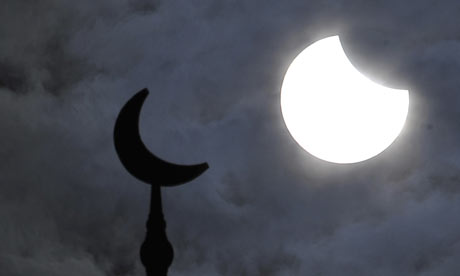
A solar eclipse in China in 2009. The partial eclipse will be the first on US soil since 1994. Photograph: Wang Peng/AP
The sun and moon will align over the earth in a rare astronomical event late on Sunday – an annular eclipse that will dim the skies over parts of Asia and North America, briefly turning the sun into a blazing ring of fire.
"It will look like a donut with a very big hole in it," Nasa space scientist Jeffrey Newmark said.
Eclipses of some type occur almost every year, but stargazers have not seen an annular – shaped like a ring – eclipse on US soil since 1994, and the next one is not to occur until 2023. That is because the phenomenon requires a particular set of orbital dynamics, Newmark said.
An annular eclipse occurs when the moon's orbit is at its furthest point from the Earth and closer to the much larger sun. That juxtaposition allows the moon to block more than 90% of the sun's rays when the two orbs slide into alignment in space, Newmark explains.
"It's like moving your fist in front of your eyes," he said. "You can block out the view of a whole mountain. It's the same kind of effect."
The eclipse will first become visible over southern Asia and then move across the Pacific to the north-west. Traveling on diagonal path toward the south-east, the eclipse will cross over parts of Oregon, Nevada, Utah, Arizona and New Mexico, before disappearing in Texas with the sunset.
Sunday's eclipse won't turn day into night, but daylight will to fade as the moon slides in front of the sun, much like turning down a household dimmer switch, and then slowly return as the moon moves away.
From start to finish, the eclipse will be visible for just under two hours. A view of the so-called "ring of fire" spectacle at the eclipse's peak, however, will only last about four minutes, and even then will only be visible to viewers positioned along the centerline of the eclipse's path.
"If you're off that swath, you'll only see a partial eclipse," said Inese Ivans, an assistant professor of astronomy and astrophysics at the University of Utah. "And there are parts of the world that will see no eclipse at all."
In Utah, the "sweet spot" for viewing the full eclipse is Kanarraville, a community of just 355 residents about 230 miles south of Salt Lake City. Accessed by an old two-lane highway, the rural town has just has just two businesses - a campground and a nursery - plus a church, a town hall and postage stamp-sized post office.
Excitement over the eclipse has Kanarraville's residents prepping a community baseball field for an estimated 5,000 stargazing on Sunday sitors, Town Clerk David Ence said.
"It's a little overwhelming. We're usually off the beaten path, but we're willing to open our town to all," an excited Ence said. "I think it's really going to be one of the best shows nature puts on."
Area officials say thousands more astrotourists are expected to attend so-called "star parties" at other locations across the region, including Zion National Park, Bryce Canyon National Park and Cedar Breaks National Monument.
Scientists caution eclipse viewers not to look directly at the sun during Sunday's solar event, as doing so could damage the eyes. Newmark and Ivans recommend astro-enthusiasts look at the eclipse through specially designed glasses or telescopes. Viewers can also use a cardboard box to make a pin-hole camera and project an image of the eclipse onto a piece of paper for safe viewing.
Despite the infrequent nature of an annular eclipse, Ivans said the event has not particular significance, but rather is part of the normal astronomical cycle. Still, she said the dramatic change in they way people experience the sun and moon are bound to pique curiosities and inspire a sense of wonder or awe.
"It reminds us that the earth is spinning. That everything is constantly in motion," Ivans said. "This sort of gives you a chance to step out and remember 'oh yeah' there a lot of stuff out there that we don't know anything about."




